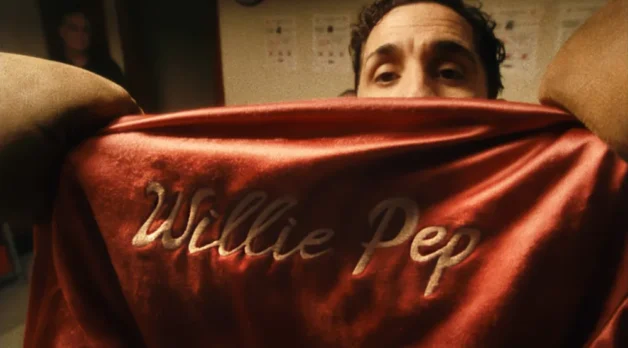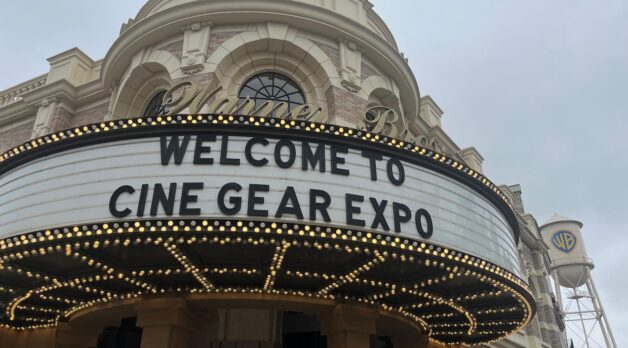Production
Filmmaking - Production
Featured
“How Would Frederick Wiseman Order This Procession of Images?”: Making Robert Kolodny’s The Featherweight
 #image_title
#image_title
Robert Kolodny’s Venice-premiering The Featherweight is the dramatic story of real-life boxer Willie Pep as he exits retirement to attempt a comeback in the ring — all as he’s shadowed by a documentary crew. The film’s action occurs two decades… Read more
David Lynch on (Just) Making the Day
 #image_title
#image_title
“Did you make the day?” That’s the first question financiers and production execs will ask after a first day — or, really, any day — of shooting. “Making the day” means completing all the scenes on the call sheet so… Read more
AI Is Already Changing Filmmaking: How Filmmakers Are Using These New Tools in Production and Post
 Axle's AI platform in action
Axle's AI platform in action
When Sora, OpenAI’s video generator model, hit the internet in February, realistic-looking demo videos flooded social media, usually accompanied by some form of “RIP Hollywood” commentary. While Sora still isn’t publicly available, between Runway, Pika and a slew of other… Read more
Cine Gear Expo 2024: 17 Cameras, LED (and Traditional) Lights, Lenses and Remote Camera Controls We Loved

Every start of summer, the Cine Gear Expo comes to Los Angeles. Initially held on the Paramount lot, the Expo had a short stint at the LA Convention Center for two pandemic years before landing this yearat the Warner Brothers… Read more
-
Las Cruces Days: Making Sundance Grand Prize-Winner In the Summers Using New Mexico Tax Credits

Alessandra Lacorazza’s In the Summers is a film of moments spread across years—moments quiet and seemingly insignificant, as well as larger events whose significance is downplayed at the time only to be properly understood years later. It’s the story of two teenage girls who, each summer, are sent by their mom to spend a few weeks with their charismatic yet irresponsible father, whose ability to love and be a parent is continually undermined by his addictions to drugs and alcohol. Winner of the Grand Jury U.S. Dramatic Competition prize at this year’s Sundance Film Festival, In the Summers finds a […]
-
Clothes Tell the Story: Costume Designer Stacey Battat on Priscilla

From the wan pastel prairie dresses of The Virgin Suicides to the candy-colored 18th century finery of Marie Antoinette to the aughts logomania of The Bling Ring, the style in Sofia Coppola’s movies is always brilliantly cohesive, capturing a distinct, ultrafeminine vibe like no other. Coppola’s latest, the impressionist biopic Priscilla, follows Priscilla Presley (Cailee Spaeny) from timid ’50s teenager to wife of Elvis (Jacob Elordi) to, finally, a liberated woman, using gorgeous midcentury fashions to capture an often painful journey into the heady world of celebrity. Spanning from 1959 to 1972—one of modern fashion’s richest transitional eras—Priscilla’s wardrobe alternately […]
-
“A Solutions-Based Intervention”: Facet Founder Maida Lynn On Her New Program Supporting Doc Producers

After supporting a range of programs uplifting the independent film community, including Sundance’s Art of Nonfiction and the Dear Producer Award, philanthropist, grant maker and producer and executive producer (Pahokee, Aleph, The Tuba Thieves), Maida Lynn recently announced through her company Facet a new “experimental” initiative, the Producer Group. Rather than the traditional model of providing project-specific support that sees grantees working individually, and different in many ways from the prevalent “lab” model, where supported filmmakers gather for brief bursts of mentorship from industry professionals, the Producer Group will attempt to foster collaboration between producers and “create a space for […]
-
Vu One: Vu’s New All-in-One Virtual Production Studio

Vu just announced a new product that aims to make virtual production a lot more accessible: the Vu One. It’s two parts. One part turnkey virtual production studio in a (very, very, big) box. One part Vu’s Virtual Studio, a software platform that makes creating and running virtual scenes a lot easier. Let’s break down both parts. Complete Virtual Production Setup Vu One offers a complete, configurable VP setup, which includes: LED Wall by Unilumin, with sizing starting at 13×9 ft Media Server by Puget Systems LED Processor by Megapixel Stereoscopic camera tracker (more on that below) Optional camera tracker […]
-
“If I Ever Need to Rob a Bank…”: Melissa Miller Costanzo on Directing the Romantic Comedy The List

I got a call from my agents, and they told me they had a script they wanted me to read. It was called The List, a broad romantic comedy about a woman who finds out her fiancé had slept with someone on his celebrity free pass list, so she decides to go to Los Angeles and try to get with someone from hers. My initial thoughts were, great concept, and why me? When I finished the script my thoughts were, needs some work, and why me? My first film was something I had written and directed called All These Small […]
-
Behind the Scenes of a Car Chase

Action director Lawrence Ribeiro has appeared in Filmmaker‘s pages before, writing about pre-viz’ing a fight scene and stunt training. Recently he has been directing a series of car chase short films, with the latest, Part Deux: The Chase, racking up 1.5 million views on YouTube. As he writes, these days he’s “working to expand Action Realism with upcoming projects that marry speed and movement with legendary talents in music and sound.” Here, in a conversation submitted by production company Art & Action Productions, he answers questions about the film, which can also be watched below. What was the purpose behind […]






